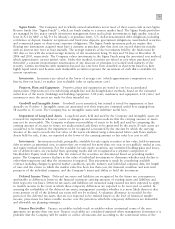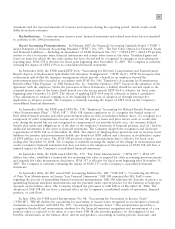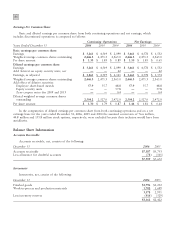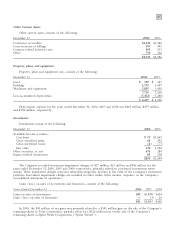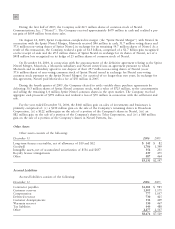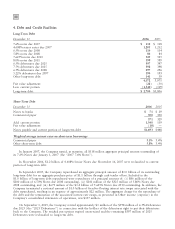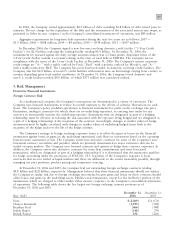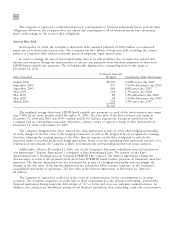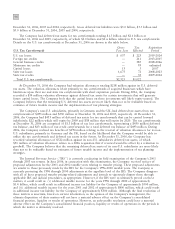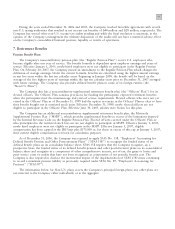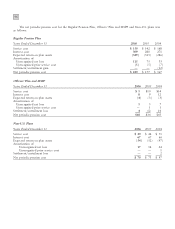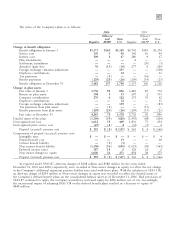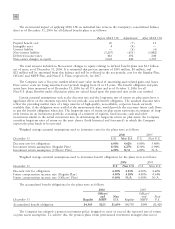Motorola 2006 Annual Report Download - page 97
Download and view the complete annual report
Please find page 97 of the 2006 Motorola annual report below. You can navigate through the pages in the report by either clicking on the pages listed below, or by using the keyword search tool below to find specific information within the annual report.
89
In 2004, the Company retired approximately $2.3 billion of debt, including $1.8 billion of debt retired prior to
maturity. The net charge for the repurchase of the debt and the termination of the associated interest rate swaps, as
presented in Other income (expense) in the Company's consolidated statements of operations, was $81 million.
Aggregate requirements for long-term debt maturities during the next five years are as follows: 2007 Ì
$1.3 billion; 2008 Ì $198 million; 2009 Ì $4 million; 2010 Ì $534 million; 2011 Ì $607 million.
In December 2006, the Company signed a new five-year revolving domestic credit facility (""5-Year Credit
Facility'') for $2.0 billion, replacing the existing facility totaling $1.0 billion. At December 31, 2006, the
commitment fee assessed against the daily average amounts unused was 6.5 basis points. Important terms of the
5-Year Credit Facility include a covenant relating to the ratio of total debt to EBITDA. The Company was in
compliance with the terms of the 5-year Credit Facility at December 31, 2006. The Company's current corporate
credit ratings are ""A¿'' with a stable outlook by Fitch, ""Baa1'' with a positive outlook by Moody's, and ""A¿''
with a stable outlook by S&P. The Company has never borrowed under its domestic revolving credit facilities. The
Company also has $2.0 billion of non-U.S. credit facilities with interest rates on borrowings varying from country to
country depending upon local market conditions. At December 31, 2006, the Company's total domestic and
non-U.S. credit facilities totaled $4.0 billion, of which $175 million was considered utilized.
5. Risk Management
Derivative Financial Instruments
Foreign Currency Risk
As a multinational company, the Company's transactions are denominated in a variety of currencies. The
Company uses financial instruments to reduce its overall exposure to the effects of currency fluctuations on cash
flows. The Company's policy prohibits speculation in financial instruments for profit on the exchange rate price
fluctuation, trading in currencies for which there are no underlying exposures, or entering into trades for any
currency to intentionally increase the underlying exposure. Instruments that are designated as part of a hedging
relationship must be effective at reducing the risk associated with the exposure being hedged and are designated as
a part of a hedging relationship at the inception of the contract. Accordingly, changes in market values of hedge
instruments must be highly correlated with changes in market values of underlying hedged items both at the
inception of the hedge and over the life of the hedge contract.
The Company's strategy in foreign exchange exposure issues is to offset the gains or losses on the financial
instruments against losses or gains on the underlying operational cash flows or investments based on the operating
business units' assessment of risk. The Company enters into derivative contracts for some of the Company's non-
functional currency receivables and payables, which are primarily denominated in major currencies that can be
traded on open markets. The Company uses forward contracts and options to hedge these currency exposures. In
addition, the Company enters into derivative contracts for some firm commitments and some forecasted
transactions, which are designated as part of a hedging relationship if it is determined that the transaction qualifies
for hedge accounting under the provisions of SFAS No. 133. A portion of the Company's exposure is from
currencies that are not traded in liquid markets and these are addressed, to the extent reasonably possible, through
managing net asset positions, product pricing and component sourcing.
At December 31, 2006 and 2005, the Company had net outstanding foreign exchange contracts totaling
$4.8 billion and $2.8 billion, respectively. Management believes that these financial instruments should not subject
the Company to undue risk due to foreign exchange movements because gains and losses on these contracts should
offset losses and gains on the underlying assets, liabilities and transactions, except for the ineffective portion of the
instruments, which are charged to Other within Other income (expense) in the Company's consolidated statements
of operations. The following table shows the five largest net foreign exchange contract positions as of
December 31, 2006 and 2005:
December 31,
December 31,
Buy (Sell)
2006
2005
Euro $(2,069) $(1,076)
Chinese Renminbi (1,195) (728)
Brazilian Real (466) (348)
Indian Rupee (148) (70)
British Pound 252 (226)


